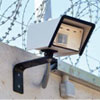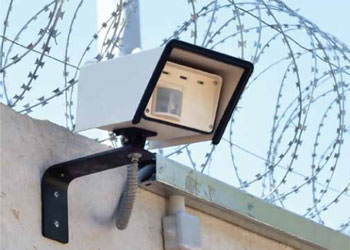
On The Fence Line
Good security means a layered approach; great security begins at the perimeter
- By Patricia Logue
- Apr 01, 2012
 Susceptibility to an attack begins with an unprotected perimeter. In the past, an unprotected perimeter often meant the opportunity for myriad security breaches, loss of assets and the chance for loss of human life. Unfortunately, we’ve learned through catastrophic events that an unprotected perimeter claims lives and destroys assets; the threat of intrusions continues to be a major concern for critical infrastructures, government and military facilities, transportation hubs and major commercial centers.
Susceptibility to an attack begins with an unprotected perimeter. In the past, an unprotected perimeter often meant the opportunity for myriad security breaches, loss of assets and the chance for loss of human life. Unfortunately, we’ve learned through catastrophic events that an unprotected perimeter claims lives and destroys assets; the threat of intrusions continues to be a major concern for critical infrastructures, government and military facilities, transportation hubs and major commercial centers.
In the past, sensor and surveillance systems were prone to “false positives” or nuisance alarms, with few options providing appropriate intrusion analysis, making it difficult for first responders to react in a timely manner. Today, there are numerous options for sensor and surveillance technologies available for perimeter security, satisfying even the most challenging security scenarios and easily integrating with existing systems and budget requirements.
Following is a brief overview of perimeter security considerations and new technologies available.
Considerations When Designing a Perimeter Security System
The key to appropriately protecting perimeters is tailoring the sensor and surveillance system to meet unique requirements of each individual site. Even the best sensors available on the market today will deliver less-than-best results if they are not properly tailored to the site.
- What are the potential threats and/or asset protection objectives? Is the perimeter susceptible to threats that are airborne, waterborne, land-based or a combination of all three? Is the objective to protect lives, as is the case at a national park or sporting event, or to provide a solid foundation for protection and continuity of operations, as at major transportation hubs, ports and harbors? Understanding your threat/protect objectives presents unique challenges to protect a perimeter.
- What do you want to protect/detect? An electrical grid? A busy airport with multiple borders? A historic site with high pedestrian traffic? After defining the unique protection challenges at each site, you can better understand the threats that are present that you need to protect against.
- What are the operational climate conditions? Are extreme temperatures, high winds, driving rains, sand or blowing sea spray routinely part of the environment? For example, if the installation is in an area prone to high winds, make sure the system has advanced signal processing to prevent generating nuisance alarms during high wind gusts while maintaining full sensitivity to an intrusion.
- At what range do you need to “see”? Understanding the range at which you need to be able to see your threat or intruder is critical, as is knowing how much advance notice is required to launch an appropriate response. Understanding these factors will help to create a working timeline for response. Defining what it means to “see a target” requires using Johnson criteria and distinguishing between degrees of “seeing.” For mere detection, you must determine the range needed to be able to detect if an object is present. Recognition involves actually seeing what type of object it is and being able to make the distinction between human, car, truck, animal or any other object. Identification, often used in the military, means seeing if someone is “friend or foe”—a threat or not. These measures need to be fully defined in order to select the proper sensor range and technology required.
- What type of “boundaries” make up your perimeter—do they involve urban development, water, roadways, woods, open terrain, mountains, buildings, pedestrian traffic, animal activity or human activity? Clearly, each setting presents a unique set of challenges to ensure the perimeter is not violated by an outside threat and needs to be taken into consideration when designing a perimeter surveillance system.
Each perimeter situation has a set of unique environmental challenges that must be taken into consideration when selecting the sensors and designing and installing the system. Failing to take these factors into consideration can result in a spike in false-positive nuisance alarms and a possible unprotected perimeter.
Layered Defense
A fundamental aspect to securing perimeters is implementing a layered defense approach. The more layers or obstacles present, the more the intruder or threat needs to penetrate to reach his or her target, the higher the opportunity the threat will be detected, leaving the perimeter secure. Each of the individual layers or components needs to complement each other, working together to protect the perimeter against known and perceived threats.
Layers include deterrence, delaying, detection, assessment and response. Threat and disruption protection through deterrence includes fences, security guards and warning signs.
Reduction of asset damage through the use of delaying mechanisms includes fence lines and security staff.
Threat or disruption detection includes surveillance sensors, motion detectors and CCTV.
Incident assessment involves the appropriate response to incidents and determination of damage levels.
Response procedures might involve first responders and emergency response processes.
Fiber Optic Sensors
Fiber optic sensing systems are a relatively new technology but are quickly becoming a popular choice for perimeter security systems due to their proven performance over the past decade. These systems are a widely accepted choice for being easily available and highly tunable to compensate for environmental conditions in the field, such as extreme temperature and weather factors. These sensor systems do not require a power source; are resistant to lightning strikes, electromagnetic interference (EMI), radiofrequency interference (RFI) or other electrical signals; and can be used over long distances.
A zone-based fiber optic sensor system consists of a central processing unit— a based controller, installed on the fence line, and a fiber optic cable attached to the fence fabric and connected to the controller. Light from a laser is sent down the fiber, and the returned light is compared to determine if there are any “light pattern” changes resulting from the bending of the fiber optic cable caused by a disturbance on the fence line.
In a typical application, the fiber optic sensing cables are mounted directly to the fence line using twist ties. A fence in good condition and a solid fence installation are necessary for reliable detection. Fences that are free of holes, swaying posts, loose signs and vibrations will maximize the system performance. With zone-based systems, the more activity that exists around the fence, the lower the sensitivity setting for the system and the less likely the system will detect a threat or intruder.
Infrared Detection Systems
Infrared sensors detect energy generated by external sources, particularly the thermal energy given off by people in the infrared range. Active infrared sensors generate a beam of infrared energy and react to a change in the frequency or an interruption in the received energy when an intruder passes through the protected area. Infrared technology can be employed in unattended ground sensors (UGS) to provide added layers of security.
A UGS passive infrared device detects the thermal energy of an intruder, similar to a thermal camera, and can signal an alarm on the thermal movement. An active infrared sensor system is made up of a transmitter and a receiver. The transmitter emits a multiple frequency beam to the remote receiving unit, creating an “infrared fence” between the transmitter and the receiver. The receiver then converts the infrared energy into an electrical signal. The receiving unit monitors the electrical signal and generates an alarm when the signal drops below a preset threshold. An intruder passing through the protected area will interrupt the infrared signal, causing it to fall below the threshold, and generate an alarm.
Video Analytics
As a basic explanation, video analytics use computers to scan incoming video feeds and automatically identify items of interest without having a security operator constantly monitor the video. Common uses of video analytics are intrusion detection, monitoring people and traffic, detecting objects left behind, and license plate recognition, all key aspects of perimeter security.
Video analytics is a technology used to analyze video feed from a camera to monitor specific changes and behavior of the monitored area by comparing the current scene with a predetermined ambient scene of the area. When sufficient change in the image or behavior is detected by the video analytics, an alarm is generated and the intrusion scene is displayed at the monitoring station.
There have been significant advances in video analytics in recent years, with higher-quality systems now including an image-tracking feature that can monitor multiple and separate intruders simultaneously by drawing a different colored line around each intruder and creating a colored trail line of where he or she has been.
Clearly, there are many variables to consider when defining needs for a perimeter security system, and we’ve only scratched the surface of the technologies available. Starting by understanding the assets you are trying to protect and what you are trying to detect will lay the groundwork for defining the appropriate system for your unique perimeter surveillance needs.
This article originally appeared in the April 2012 issue of Security Today.